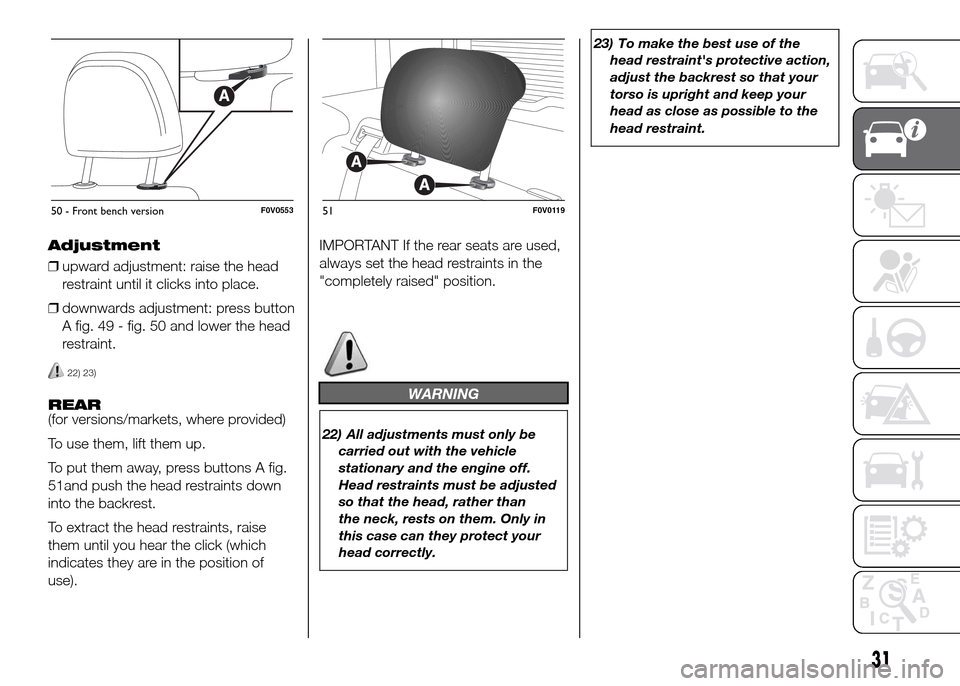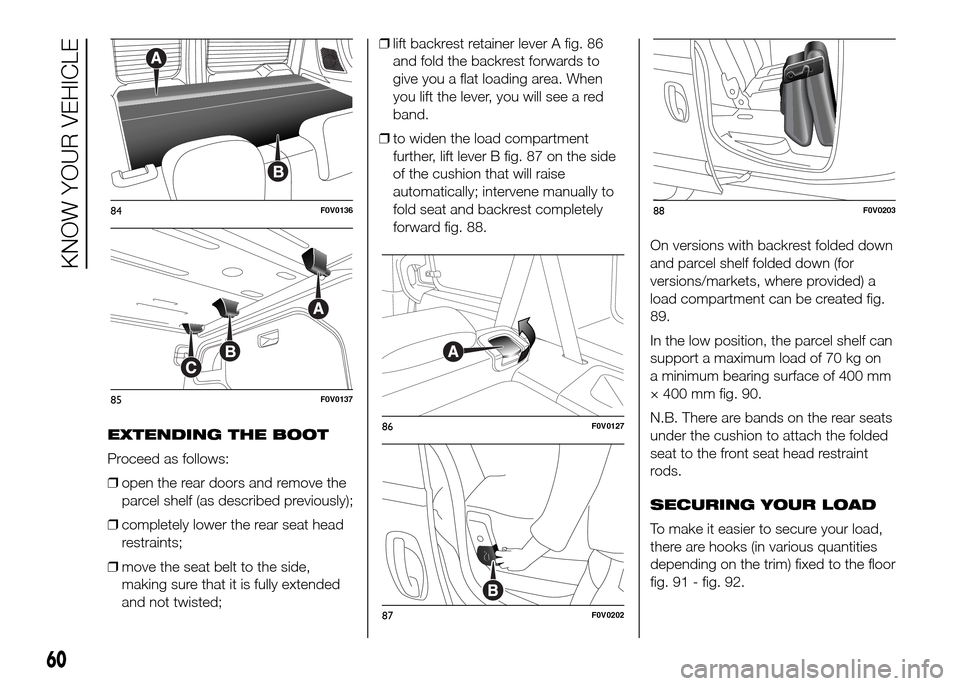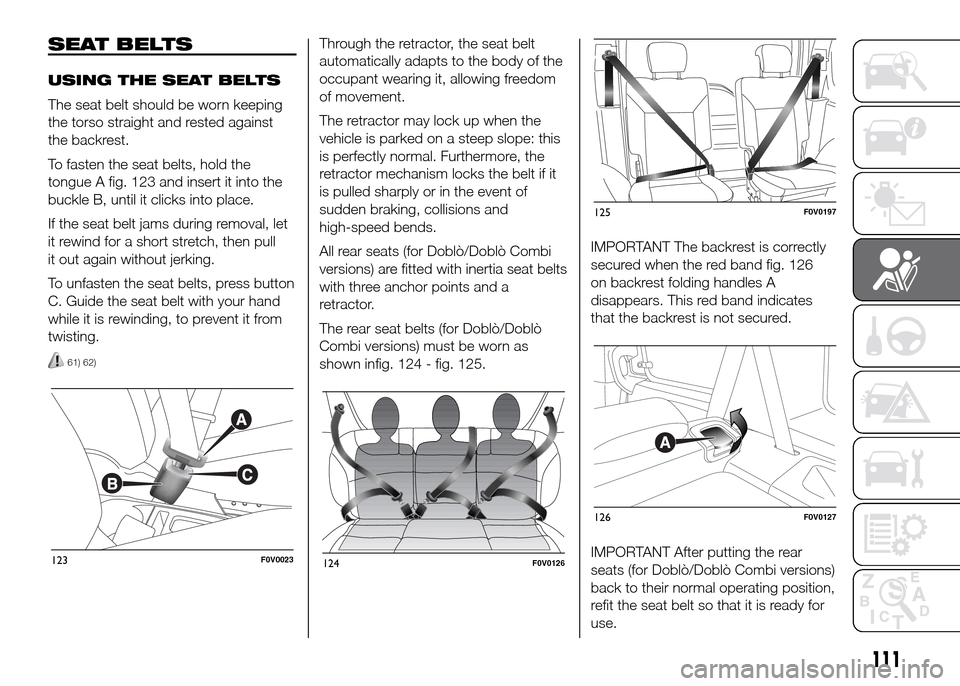2016 FIAT DOBLO PANORAMA seats
[x] Cancel search: seatsPage 35 of 323

Adjustment
❒upward adjustment: raise the head
restraint until it clicks into place.
❒downwards adjustment: press button
A fig. 49 - fig. 50 and lower the head
restraint.
22) 23)
REAR
(for versions/markets, where provided)
To use them, lift them up.
To put them away, press buttons A fig.
51and push the head restraints down
into the backrest.
To extract the head restraints, raise
them until you hear the click (which
indicates they are in the position of
use).IMPORTANT If the rear seats are used,
always set the head restraints in the
"completely raised" position.WARNING
22) All adjustments must only be
carried out with the vehicle
stationary and the engine off.
Head restraints must be adjusted
so that the head, rather than
the neck, rests on them. Only in
this case can they protect your
head correctly.23) To make the best use of the
head restraint's protective action,
adjust the backrest so that your
torso is upright and keep your
head as close as possible to the
head restraint.
50 - Front bench versionF0V055351F0V0119
31
Page 51 of 323

PASSENGER
COMPARTMENT HEATING
Proceed as follows:
❒turn knob A to the red section;
❒turn knob B to the required speed;
❒turn knob C to:
to warm the feet and demist the
windscreen at the same time
warms the feet and keeps the face
cool (bi-level function)
to warm the feet of those in the front
and rear seats.
❒to turn off internal air recirculation
(button E LED off).
FAST FRONT WINDOW
DEMISTING/DEFROSTING
Proceed as follows:
❒press the
button
❒turn knob A fully to the right;
❒turn knob B to
;
❒turn knob C to
;
❒to turn off internal air recirculation
(button E LED off).
After demisting/defrosting, operate the
controls to maintain optimum visibility
conditions.Window demisting
In the event of considerable external
moisture and/or rain and/or large
differences in temperature inside and
outside the passenger compartment,
perform the following preventive
window demisting procedure:
❒press the
button
❒to turn off internal air recirculation
(button E LED off);
❒turn knob A to the red section;
❒turn knob B to the second speed
level;
❒turn knob C to
or toif the
windows do not show signs of
misting up deactivate the internal air
recirculation (LED on button E off)
The climate control system is
very useful for demisting the windows
more quickly: just carry out the above
procedure and activate the system
by pressing the
button.
HEATED REAR WINDOW
AND DOOR MIRRORS
DEMISTING/DEFROSTING
(for versions/markets, where provided)
Press button F
to activate: when
this function is activated, the LED
on button F
lights up.This function is timed and will turn off
automatically after 20 minutes. Press
button F
again to switch the
function off in advance.
IMPORTANT Do not apply stickers on
the inside of the rear window over
the heating filaments to avoid damage.
ADJUSTING THE FAN
SPEED
To ventilate the passenger
compartment well, proceed as follows:
❒fully open the central and side air
diffusers;
❒turn knob A to the blue section;
❒turn knob B to the required speed;
❒turn knob C to
❒to turn off internal air recirculation
(button E LED off).
INTERNAL AIR
RECIRCULATION
ACTIVATION
Press button E: when the function is
on, the button LED lights up.
47
Page 63 of 323

The handle is enabled after pressing the
third button on the remote control or
by operating the unlocking button from
the interior of the vehicle. Opening
can also take place by using the
mechanical key or the metal insert of
the remote control key in the driver side
door pawl.
7)
EMERGENCY OPENING
FROM THE INSIDE
In the event of an emergency, you can
open the boot from inside the vehicle
as follows:
❒open the sliding side door and fully
fold the rear seats;
❒from inside the boot, press lever A
fig. 82 and open the tailgate.EMERGENCY OPENING
OF THE SWING DOORS
FROM THE INSIDE
In the event of an emergency, you can
open the boot from inside the vehicle
as follows:
❒open the sliding side door and lower
the backrest of the rear seat to give
you access to the load compartment
(Doblò/Doblò Combi versions);
or
❒open the sliding side door (Cargo
versions);
❒use device A fig. 83 located on the
inside of the right-hand swing door;
❒open the left-hand swing door by
pulling on its handle (see "Doors"
in this section).REMOVING THE PARCEL
SHELF
The parcel shelf consists of two parts.
To remove it completely, proceed as
follows:
❒open the rear swing door; raise the
front part A fig. 84, unhooking pin A
fig. 85 from its housing
❒raise rear part B fig. 84, unhooking
pins B and C fig. 85 from their
housings.
If the seat is completely folded down,
remove the parcel shelf as described
and store it horizontally between the
back of the front seats and the folded
rear seat.
To refit the parcel shelf, follow the same
procedure in reverse.
81F0V0340
82F0V013583F0V0080
59
Page 64 of 323

EXTENDING THE BOOT
Proceed as follows:
❒open the rear doors and remove the
parcel shelf (as described previously);
❒completely lower the rear seat head
restraints;
❒move the seat belt to the side,
making sure that it is fully extended
and not twisted;❒lift backrest retainer lever A fig. 86
and fold the backrest forwards to
give you a flat loading area. When
you lift the lever, you will see a red
band.
❒to widen the load compartment
further, lift lever B fig. 87 on the side
of the cushion that will raise
automatically; intervene manually to
fold seat and backrest completely
forward fig. 88.
On versions with backrest folded down
and parcel shelf folded down (for
versions/markets, where provided) a
load compartment can be created fig.
89.
In the low position, the parcel shelf can
support a maximum load of 70 kg on
a minimum bearing surface of 400 mm
× 400 mm fig. 90.
N.B. There are bands on the rear seats
under the cushion to attach the folded
seat to the front seat head restraint
rods.
SECURING YOUR LOAD
To make it easier to secure your load,
there are hooks (in various quantities
depending on the trim) fixed to the floor
fig. 91 - fig. 92.
84F0V0136
85F0V0137
86F0V0127
87F0V0202
88F0V0203
60
KNOW YOUR VEHICLE
Page 65 of 323

WARNING
35) If you are travelling in areas with
few filling stations and you want
to transport fuel in a spare tank,
comply with the law by using only
an approved, suitably secured
tank. However, the risks of fire in
the case of collision increase
anyway.
36) Never exceed the maximum
allowed load in the boot, see
the “Technical specifications”
chapter. Also make sure that the
objects you place in the boot have
been properly secured, to avoid
them from being thrown forward
consequent to sudden braking
and injuring your passengers.37) If you are travelling in areas with
few filling stations and you want
to transport fuel in a spare tank,
comply with the law by using only
an approved, suitably secured
tank. Anyway, by doing so, you
increase the risk of fire in the
event of an accident with your
vehicle.
38) Never exceed the maximum
allowed load in the boot (see
the "Technical specifications"
chapter). Also make sure that the
objects you place in the boot
have been properly secured, to
avoid them from being thrown
forward consequent to sudden
braking and injuring your
passengers.
39) You must not use the folded
rear seat to carry luggage. The
load could be thrown forward into
the backrest of the front seats,
seriously injuring the occupants.
40) Make sure that the objects are
positioned carefully and fixed to
the hooks on the floor to prevent
them being flung forwards in
the event of sharp braking and
causing injury to the passengers.
89F0V0204
400mm400mm
70 kg
90F0V0212
91F0V0114
92F0V0122
61
Page 68 of 323

FRONT ODDMENT SHELF
(for versions/markets, where provided)
The front storage compartment is
fitted above the sun visors fig. 103 and
is designed for the quick storage of
light objects (e.g. documents, road
maps etc.).
CENTRAL ODDMENT
SHELF
(for versions/markets, where provided)
The central oddment shelf fig. 104,
accessible from the rear seats, is
intended for storing light objects.
UPPER REAR STORAGE
COMPARTMENT
(for versions/markets, where provided)
It can be accessed from the rear, with
the tailgate open.To access the compartment, open the
flap fig. 105 by pulling the dedicated
handle downwards.
The shelf can also be accessed from
inside the passenger compartment
through two flaps B fig. 106 that slide
outwards.
IMPORTANT The shelf can support a
maximum weight of 7 kg.CIGAR LIGHTER
(for versions/markets, where provided)
Press button A fig. 107 - fig. 108
(depending on the version) to switch on
the cigar lighter when the ignition key
is turned to MAR. After a few seconds
the button goes back to its initial
position and the cigar lighter is ready for
use.
IMPORTANT Always make sure the
cigar lighter is switched off.
42)
ASHTRAY
(for versions/markets, where provided)
The ashtray is a removable spring-
loaded plastic box fig. 109 that can be
fitted into the cup/can holders in the
central console.
43)
103F0V0061
104F0V0545
105F0V0559
106F0V0543
64
KNOW YOUR VEHICLE
Page 70 of 323

ROOF RACK/SKI
RACK
44) 45)
8) 9)
FASTENERS
The fasteners are located at points A, B
and C fig. 112.
ROOF RAILS
(for versions/markets, where provided)
On some versions, the vehicle has
two longitudinal bars which, with the
addition of special accessories, can be
used to carry various objects (e.g.
skis, surfboards, etc.).
WARNING
44) Strictly adhere to the laws in
force concerning maximum
clearance.
45) Check that the attachment fixing
screws are tight after a few
kilometres.
IMPORTANT
8) Evenly distribute the load and
take into account, when driving,
the increased responsiveness
of the vehicle to side wind.
9) Never exceed the maximum
permitted loads (see chapter
“Technical specifications”).
HEADLIGHTS
LIGHT BEAM ALIGNMENT
The correct alignment of the headlights
is essential for the comfort and safety
of the driver and other road users.
To ensure the best visibility when
travelling with the headlights on, the
headlight alignment must be correct.
Contact a Fiat Dealership to have
the headlights checked and adjusted.
HEADLIGHT ALIGNMENT
CORRECTOR
This device works with the ignition key
in the MAR position and the dipped
beam headlights on.
The vehicle tilts backwards when it is
laden, raising the beam. The beams
must therefore be realigned in this case.
Headlight alignment
adjustment
Press the
andfig. 113 buttons
on the control panel to adjust.
The display located on the instrument
panel provides a visual indication of the
adjustment position.
Position 0 - one or two people in the
front seats.
Position 1 - five people.
112F0V0123
66
KNOW YOUR VEHICLE
Page 115 of 323

SEAT BELTS
USING THE SEAT BELTS
The seat belt should be worn keeping
the torso straight and rested against
the backrest.
To fasten the seat belts, hold the
tongue A fig. 123 and insert it into the
buckle B, until it clicks into place.
If the seat belt jams during removal, let
it rewind for a short stretch, then pull
it out again without jerking.
To unfasten the seat belts, press button
C. Guide the seat belt with your hand
while it is rewinding, to prevent it from
twisting.
61) 62)
Through the retractor, the seat belt
automatically adapts to the body of the
occupant wearing it, allowing freedom
of movement.
The retractor may lock up when the
vehicle is parked on a steep slope: this
is perfectly normal. Furthermore, the
retractor mechanism locks the belt if it
is pulled sharply or in the event of
sudden braking, collisions and
high-speed bends.
All rear seats (for Doblò/Doblò Combi
versions) are fitted with inertia seat belts
with three anchor points and a
retractor.
The rear seat belts (for Doblò/Doblò
Combi versions) must be worn as
shown infig. 124 - fig. 125.IMPORTANT The backrest is correctly
secured when the red band fig. 126
on backrest folding handles A
disappears. This red band indicates
that the backrest is not secured.
IMPORTANT After putting the rear
seats (for Doblò/Doblò Combi versions)
back to their normal operating position,
refit the seat belt so that it is ready for
use.
123F0V0023124F0V0126
125F0V0197
126F0V0127
111